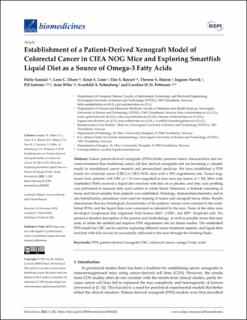| dc.contributor.author | Samdal, Helle | |
| dc.contributor.author | Olsen, Lene Christin | |
| dc.contributor.author | Grøn, Knut Sverre | |
| dc.contributor.author | Røyset, Elin Synnøve | |
| dc.contributor.author | Høiem, Therese Stork | |
| dc.contributor.author | Nervik, Ingunn | |
| dc.contributor.author | Sætrom, Pål | |
| dc.contributor.author | Wibe, Arne | |
| dc.contributor.author | Schønberg, Svanhild Margrethe Arentz | |
| dc.contributor.author | Pettersen, Caroline Hild | |
| dc.date.accessioned | 2021-03-29T09:09:27Z | |
| dc.date.available | 2021-03-29T09:09:27Z | |
| dc.date.created | 2021-03-17T15:06:05Z | |
| dc.date.issued | 2021 | |
| dc.identifier.issn | 2227-9059 | |
| dc.identifier.uri | https://hdl.handle.net/11250/2735897 | |
| dc.description.abstract | Cancer patient-derived xenografts (PDXs) better preserve tumor characteristics and microenvironment than traditional cancer cell line derived xenografts and are becoming a valuable model in translational cancer research and personalized medicine. We have established a PDX model for colorectal cancer (CRC) in CIEA NOG mice with a 50% engraftment rate. Tumor fragments from patients with CRC (n = 5) were engrafted in four mice per tumor (n = 20). Mice with established PDXs received a liquid diet enriched with fish oil or placebo, and fatty acid profiling was performed to measure fatty acid content in whole blood. Moreover, a biobank consisting of tissue and blood samples from patients was established. Histology, immunohistochemistry and in situ hybridization procedures were used for staining of tumor and xenograft tissue slides. Results demonstrate that key histological characteristics of the patients’ tumors were retained in the established PDXs, and the liquid diets were consumed as intended by the mice. Some of the older mice developed lymphomas that originated from human Ki67+, CD45+, and EBV+ lymphoid cells. We present a detailed description of the process and methodology, as well as possible issues that may arise, to refine the method and improve PDX engraftment rate for future studies. The established PDX model for CRC can be used for exploring different cancer treatment regimes, and liquid diets enriched with fish oil may be successfully delivered to the mice through the drinking flasks. | en_US |
| dc.language.iso | eng | en_US |
| dc.publisher | MDPI | en_US |
| dc.rights | Navngivelse 4.0 Internasjonal | * |
| dc.rights.uri | http://creativecommons.org/licenses/by/4.0/deed.no | * |
| dc.title | Establishment of a patient-derived xenograft model of colorectal cancer in CIEA NOG mice and exploring smartfish liquid diet as a source of omega-3 fatty acids | en_US |
| dc.type | Peer reviewed | en_US |
| dc.type | Journal article | en_US |
| dc.description.version | publishedVersion | en_US |
| dc.source.volume | 9 | en_US |
| dc.source.journal | Biomedicines | en_US |
| dc.source.issue | 3 | en_US |
| dc.identifier.doi | https://doi.org/10.3390/biomedicines9030282 | |
| dc.identifier.cristin | 1898742 | |
| cristin.ispublished | true | |
| cristin.fulltext | original | |
| cristin.qualitycode | 1 | |

